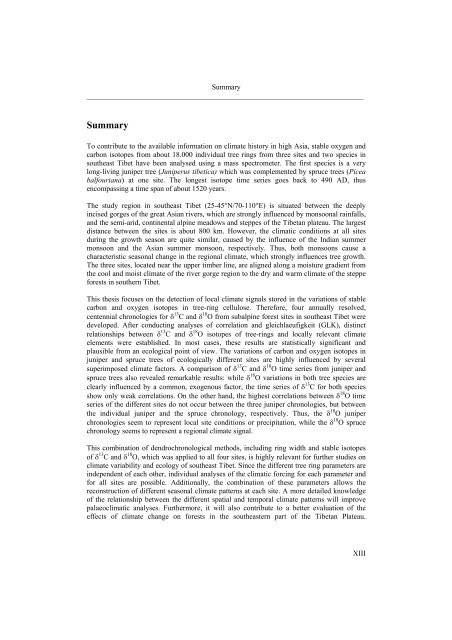Untersuchungen zur Klimavariabilität auf dem Tibetischen Plateau ...
Untersuchungen zur Klimavariabilität auf dem Tibetischen Plateau ...
Untersuchungen zur Klimavariabilität auf dem Tibetischen Plateau ...
Erfolgreiche ePaper selbst erstellen
Machen Sie aus Ihren PDF Publikationen ein blätterbares Flipbook mit unserer einzigartigen Google optimierten e-Paper Software.
Summary<br />
___________________________________________________________________________<br />
Summary<br />
To contribute to the available information on climate history in high Asia, stable oxygen and<br />
carbon isotopes from about 18.000 individual tree rings from three sites and two species in<br />
southeast Tibet have been analysed using a mass spectrometer. The first species is a very<br />
long-living juniper tree (Juniperus tibetica) which was complemented by spruce trees (Picea<br />
balfouriana) at one site. The longest isotope time series goes back to 490 AD, thus<br />
encompassing a time span of about 1520 years.<br />
The study region in southeast Tibet (25-45°N/70-110°E) is situated between the deeply<br />
incised gorges of the great Asian rivers, which are strongly influenced by monsoonal rainfalls,<br />
and the semi-arid, continental alpine meadows and steppes of the Tibetan plateau. The largest<br />
distance between the sites is about 800 km. However, the climatic conditions at all sites<br />
during the growth season are quite similar, caused by the influence of the Indian summer<br />
monsoon and the Asian summer monsoon, respectively. Thus, both monsoons cause a<br />
characteristic seasonal change in the regional climate, which strongly influences tree growth.<br />
The three sites, located near the upper timber line, are aligned along a moisture gradient from<br />
the cool and moist climate of the river gorge region to the dry and warm climate of the steppe<br />
forests in southern Tibet.<br />
This thesis focuses on the detection of local climate signals stored in the variations of stable<br />
carbon and oxygen isotopes in tree-ring cellulose. Therefore, four annually resolved,<br />
centennial chronologies for δ 13 C and δ 18 O from subalpine forest sites in southeast Tibet were<br />
developed. After conducting analyses of correlation and gleichlaeufigkeit (GLK), distinct<br />
relationships between δ 13 C and δ 18 O isotopes of tree-rings and locally relevant climate<br />
elements were established. In most cases, these results are statistically significant and<br />
plausible from an ecological point of view. The variations of carbon and oxygen isotopes in<br />
juniper and spruce trees of ecologically different sites are highly influenced by several<br />
superimposed climate factors. A comparison of δ 13 C and δ 18 O time series from juniper and<br />
spruce trees also revealed remarkable results: while δ 18 O variations in both tree species are<br />
clearly influenced by a common, exogenous factor, the time series of δ 13 C for both species<br />
show only weak correlations. On the other hand, the highest correlations between δ 18 O time<br />
series of the different sites do not occur between the three juniper chronologies, but between<br />
the individual juniper and the spruce chronology, respectively. Thus, the δ 18 O juniper<br />
chronologies seem to represent local site conditions or precipitation, while the δ 18 O spruce<br />
chronology seems to represent a regional climate signal.<br />
This combination of dendrochronological methods, including ring width and stable isotopes<br />
of δ 13 C and δ 18 O, which was applied to all four sites, is highly relevant for further studies on<br />
climate variability and ecology of southeast Tibet. Since the different tree ring parameters are<br />
independent of each other, individual analyses of the climatic forcing for each parameter and<br />
for all sites are possible. Additionally, the combination of these parameters allows the<br />
reconstruction of different seasonal climate patterns at each site. A more detailed knowledge<br />
of the relationship between the different spatial and temporal climate patterns will improve<br />
palaeoclimatic analyses. Furthermore, it will also contribute to a better evaluation of the<br />
effects of climate change on forests in the southeastern part of the Tibetan <strong>Plateau</strong>.<br />
XIII

















